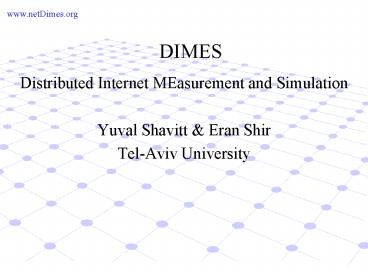DIMES PowerPoint PPT Presentation
1 / 13
Title: DIMES
1
DIMES
- Distributed Internet MEasurement and Simulation
- Yuval Shavitt Eran Shir
- Tel-Aviv University
2
What is DIMES All About?
- Let the network measure itself
- Persuade people to download our DIMES measurement
agent - Carry on experiments to measure and map the
Internet and track its growth. - Target
- 1,000s of users in the first year
- More than 10,000s of users in three years
3
How does the Internet look like?
- FFF99 The Internet topology degree distribution
obeys a power law - Dramatically changed the way researchers view the
Internet - Become the standard simulation topology
- Chen et al. 02 The Origin of Power Laws in
Internet Topologies Revisited. - FFF99 data is only partial
- There is no power law.
- Problem their data is problematic as well
4
Our claim
- All current studies are based on partial data.
- Chen et al 02 has a problem with neighbor
definition - Our initial aim collect the network topology
with high accuracy
5
Past Attempts
- Measurements were done from a few (up to 100s)
points - - too many links are missed especially in the
periphery - - measurements traffic was too dense
- Some maps were created based on central databases
- data is incossistent and partial
6
For Example Segments of ILAN as viewed from
Outside ILAN (Inside Israel)
7
Segments of ILAN as viewed from Inside Ilan
8
Are there any differences?
9
Well, Yes!
10
The Goal
- Creating a distributed platform that will enable
- Global scale measurement of Internet graph
structure, packet traffic statistics, demography - Simulation of Internet behavior under different
conditions (let the net simulate itself) - Simulation of the Internet future
- Active networks
- Novel routing algorithms
- Distributed resource allocation grid computing
- P2P
11
Challenges
- Optimize the architecture
- Minimize the number of measurements
- Expedite the discovery rate
- Flying under the NOC radar screens
- Study self-emerging agent collaboration
- Data analysis
- and more .
12
Architecture - Overview
- Building blocks
- A lightweight, programmable and sandboxed agent
installed in thousands of nodes all over the net - A planning and scheduling server(s) assigns
measurement scripts and manages experiments - Two communication channels (due to security)
- Control for script receiving and status report
- Data for measurement results transfer
- The agents have a separate (sandboxed)
communication - channel for performing measurements
13
Architecture - continue
- Each agent implements a set of measurement
modules (e.g. Ping) - The agent uses these modules according to
received scripts from server e.g. - OnTime local startTime 1800 endTime 0300
period 30m do ping 132.66.(20-127).2 - while (sysDatelt20/01/04 ilt127)
- OnTime local startTime 0330 endTime 0730 period
20m do traceroute i.0.0.1 - i
- end while
- Scripts are created by the planner in the server
according to the experiment guidelines and agent
profile - The agent schedules tasks carefully in order not
to exceed normal user traffic profile. Also,
whenever possible, TCP and UDP are used - Received results are used at the server to update
the maintained maps and other calculations
14
Architecture - Server
15
Architecture - Agent
16
Methodology
- Use uncorrelated Measurements (e.g. Ping,
Traceroute clones) to - Identify AS level topology and delay map
- Identify Routers level topology and delay map
- Identify the evolution nature of the Internet
- Use correlated measurements to
- Expedite measurement discovery
- Study routing optimality
- Study overlay networks
- Study network self-organization through agent
collaboration
17
New Algorithms
- New algorithms are developed for the two
endpoints of a DIMES experiment planning and
results analysis - The planning algorithms should enable optimal
usage of DIMES resources (i.e. agents) by
carefully assigning the right measurement tasks
in accordance with experiment objectives - Network modeling and embedding algorithms greatly
reduce agent designation overhead - The analysis and map creation algorithm should be
able to cope with data received from multitude of
sources with varying profile
18
DIMES PlanetLab
- We plan to use PlanetLab in order to leverage the
DIMES infrastructure - Initial Deployment
- Top Tier in two tiers experimental architecture
- Enablement of correlated measurements
- (How to get routing diversity?)
19
Deliverables (partial EU funding starting
date January 2004)
- Connectivity statistics including hidden links
12 months - Delay map 12 months
- Topology (K-Core, small worldness) including
hidden links 18 months - Corresponding I/O traffic statistics 24 months
- Usage mode statistics (e.g. HTTP vs. P2P)
- Traffic flow mapping
20
Growthpath directions over DIMES lifetime
Time
21
Who
- PI Yuval Shavitt
- Ph.D. students Eran Shir, Tomer Tankel, Amir
Shay - Post-doc Osnat Mokryn
- Programmer Anat Halpern
22
Thank you
- Those who wish, are encouraged to go to our
website www.netDimes.org download DIMES agents
beta version and participate in our experiments.

